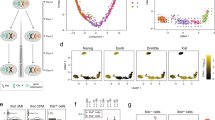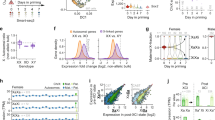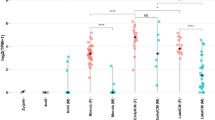Abstract
Mammalian cells from both sexes typically contain one active X chromosome but two sets of autosomes. It has previously been hypothesized that X-linked genes are expressed at twice the level of autosomal genes per active allele to balance the gene dose between the X chromosome and autosomes (termed 'Ohno's hypothesis'). This hypothesis was supported by the observation that microarray-based gene expression levels were indistinguishable between one X chromosome and two autosomes (the X to two autosomes ratio (X:AA) ∼1). Here we show that RNA sequencing (RNA-Seq) is more sensitive than microarray and that RNA-Seq data reveal an X:AA ratio of ∼0.5 in human and mouse. In Caenorhabditis elegans hermaphrodites, the X:AA ratio reduces progressively from ∼1 in larvae to ∼0.5 in adults. Proteomic data are consistent with the RNA-Seq results and further suggest the lack of X upregulation at the protein level. Together, our findings reject Ohno's hypothesis, necessitating a major revision of the current model of dosage compensation in the evolution of sex chromosomes.
This is a preview of subscription content, access via your institution
Access options
Subscribe to this journal
Receive 12 print issues and online access
$209.00 per year
only $17.42 per issue
Buy this article
- Purchase on Springer Link
- Instant access to full article PDF
Prices may be subject to local taxes which are calculated during checkout


Similar content being viewed by others
References
Ohno, S. Sex Chromosomes and Sex Linked Genes (Springer Verlag, Berlin, Germany, 1967).
Payer, B. & Lee, J.T. X chromosome dosage compensation: how mammals keep the balance. Annu. Rev. Genet. 42, 733–772 (2008).
Charlesworth, B. The evolution of chromosomal sex determination and dosage compensation. Curr. Biol. 6, 149–162 (1996).
Straub, T. & Becker, P.B. Dosage compensation: the beginning and end of generalization. Nat. Rev. Genet. 8, 47–57 (2007).
Gupta, V. et al. Global analysis of X-chromosome dosage compensation. J. Biol. 5, 3 (2006).
Nguyen, D.K. & Disteche, C.M. Dosage compensation of the active X chromosome in mammals. Nat. Genet. 38, 47–53 (2006).
Draghici, S., Khatri, P., Eklund, A.C. & Szallasi, Z. Reliability and reproducibility issues in DNA microarray measurements. Trends Genet. 22, 101–109 (2006).
Liao, B.Y. & Zhang, J. Evolutionary conservation of expression profiles between human and mouse orthologous genes. Mol. Biol. Evol. 23, 530–540 (2006).
Fu, X. et al. Estimating accuracy of RNA-Seq and microarrays with proteomics. BMC Genomics 10, 161 (2009).
Held, G.A., Grinstein, G. & Tu, Y. Modeling of DNA microarray data by using physical properties of hybridization. Proc. Natl. Acad. Sci. USA 100, 7575–7580 (2003).
Marioni, J.C., Mason, C.E., Mane, S.M., Stephens, M. & Gilad, Y. RNA-seq: an assessment of technical reproducibility and comparison with gene expression arrays. Genome Res. 18, 1509–1517 (2008).
Mortazavi, A., Williams, B.A., McCue, K., Schaeffer, L. & Wold, B. Mapping and quantifying mammalian transcriptomes by RNA-Seq. Nat. Methods 5, 621–628 (2008).
Wang, E.T. et al. Alternative isoform regulation in human tissue transcriptomes. Nature 456, 470–476 (2008).
Wang, Z., Gerstein, M. & Snyder, M. RNA-Seq: a revolutionary tool for transcriptomics. Nat. Rev. Genet. 10, 57–63 (2009).
Smith, A.M. et al. Quantitative phenotyping via deep barcode sequencing. Genome Res. 19, 1836–1842 (2009).
Pan, Q., Shai, O., Lee, L.J., Frey, B.J. & Blencowe, B.J. Deep surveying of alternative splicing complexity in the human transcriptome by high-throughput sequencing. Nat. Genet. 40, 1413–1415 (2008).
Namekawa, S.H. et al. Postmeiotic sex chromatin in the male germline of mice. Curr. Biol. 16, 660–667 (2006).
Meyer, B.J., McDonel, P., Csankovszki, G. & Ralston, E. Sex and X-chromosome-wide repression in Caenorhabditis elegans. Cold Spring Harb. Symp. Quant. Biol. 69, 71–79 (2004).
Hillier, L.W. et al. Massively parallel sequencing of the polyadenylated transcriptome of C. elegans. Genome Res. 19, 657–666 (2009).
Lin, H. et al. Dosage compensation in the mouse balances up-regulation and silencing of X-linked genes. PLoS Biol. 5, e326 (2007).
Dohm, J.C., Lottaz, C., Borodina, T. & Himmelbauer, H. Substantial biases in ultra-short read data sets from high-throughput DNA sequencing. Nucleic Acids Res. 36, e105 (2008).
Wang, J. et al. The diploid genome sequence of an Asian individual. Nature 456, 60–65 (2008).
Hillier, L.W. et al. Whole-genome sequencing and variant discovery in C. elegans. Nat. Methods 5, 183–188 (2008).
Nacher, J.C. & Akutsu, T. Recent progress on the analysis of power-law features in complex cellular networks. Cell Biochem. Biophys. 49, 37–47 (2007).
Kislinger, T. et al. Global survey of organ and organelle protein expression in mouse: combined proteomic and transcriptomic profiling. Cell 125, 173–186 (2006).
Schrimpf, S.P. et al. Comparative functional analysis of the Caenorhabditis elegans and Drosophila melanogaster proteomes. PLoS Biol. 7, e48 (2009).
Deutschbauer, A.M. et al. Mechanisms of haploinsufficiency revealed by genome-wide profiling in yeast. Genetics 169, 1915–1925 (2005).
Qian, W. & Zhang, J. Gene dosage and gene duplicability. Genetics 179, 2319–2324 (2008).
Lahn, B.T., Pearson, N.M. & Jegalian, K. The human Y chromosome, in the light of evolution. Nat. Rev. Genet. 2, 207–216 (2001).
Adler, D.A. et al. Evidence of evolutionary up-regulation of the single active X chromosome in mammals based on Clc4 expression levels in Mus spretus and Mus musculus. Proc. Natl. Acad. Sci. USA 94, 9244–9248 (1997).
Vicoso, B. & Charlesworth, B. Evolution on the X chromosome: unusual patterns and processes. Nat. Rev. Genet. 7, 645–653 (2006).
Ellegren, H. et al. Faced with inequality: chicken do not have a general dosage compensation of sex-linked genes. BMC Biol. 5, 40 (2007).
Itoh, Y. et al. Dosage compensation is less effective in birds than in mammals. J. Biol. 6, 2 (2007).
Zha, X. et al. Dosage analysis of Z chromosome genes using microarray in silkworm, Bombyx mori. Insect Biochem. Mol. Biol. 39, 315–321 (2009).
Mank, J.E. The W, X, Y and Z of sex-chromosome dosage compensation. Trends Genet. 25, 226–233 (2009).
Sultan, M. et al. A global view of gene activity and alternative splicing by deep sequencing of the human transcriptome. Science 321, 956–960 (2008).
Li, R., Li, Y., Kristiansen, K. & Wang, J. SOAP: short oligonucleotide alignment program. Bioinformatics 24, 713–714 (2008).
Carrel, L. & Willard, H.F. X-inactivation profile reveals extensive variability in X-linked gene expression in females. Nature 434, 400–404 (2005).
Acknowledgements
We thank B.-Y. Liao for sharing his processed mouse proteomic data, Y. Jiang for assistance in statistical analysis and B.-Y. Liao, J. Lu, O. Podlaha, P. Shi, W. Qian, C.-I. Wu and Y. Xing for valuable comments. Part of the work was conducted in the laboratory of Peng Shi at the State Key Laboratory of Genetic Resources and Evolution, Kunming Institute of Zoology. This work was supported by research grants from the US National Institutes of Health (to J.Z.), the National Natural Science Foundation of China (90717115 and 30871371 to X.H.; 11001280 to Xueqin Wang) and the Tianyuan Fund for Mathematics (10926200 to Xueqin Wang).
Author information
Authors and Affiliations
Contributions
X.H. and J.Z. conceived the study. Y.X., X.C. and Z.C. produced data. X.H., X.C., Y.X., J.Z., Xunzhang Wang, S.S. and Xueqin Wang analyzed data. X.H., Xunzhang Wang and S.S. provided reagents. X.H. and J.Z. wrote the paper.
Corresponding authors
Ethics declarations
Competing interests
The authors declare no competing financial interests.
Supplementary information
Supplementary Text and Figures
Supplementary Tables 1–15 and Supplementary Figures 1–5. (PDF 1085 kb)
Rights and permissions
About this article
Cite this article
Xiong, Y., Chen, X., Chen, Z. et al. RNA sequencing shows no dosage compensation of the active X-chromosome. Nat Genet 42, 1043–1047 (2010). https://doi.org/10.1038/ng.711
Published:
Issue Date:
DOI: https://doi.org/10.1038/ng.711
This article is cited by
-
RNA stability controlled by m6A methylation contributes to X-to-autosome dosage compensation in mammals
Nature Structural & Molecular Biology (2023)
-
Gene regulation in time and space during X-chromosome inactivation
Nature Reviews Molecular Cell Biology (2022)
-
Mammalian X-chromosome inactivation: proposed role in suppression of the male programme in genetic females
Journal of Genetics (2022)
-
Dosage sensitivity of X-linked genes in human embryonic single cells
BMC Genomics (2019)
-
X-chromosome upregulation is driven by increased burst frequency
Nature Structural & Molecular Biology (2019)




